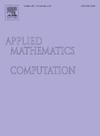无界域上欧拉方程的高效谱元法
IF 3.4
2区 数学
Q1 MATHEMATICS, APPLIED
引用次数: 0
摘要
减轻波浪离开数值域的影响一直是数值建模中的一个难题。减少波在域边界的反射对精确模拟至关重要。吸收层虽然常见,但往往会产生大量计算成本。本文介绍了一种针对二维非线性可压缩欧拉方程吸收层的 Legendre-Laguerre 基的高效应用。该方法采用拉格朗日和缩放拉盖尔基函数的张量乘积,将谱元有界域与半无限域结合起来。半无限元素用于具有瑞利阻尼的吸收层。与采用类似吸收层扩展的现有方法相比,这种方法是对可压缩和分层流欧拉方程的开创性应用,大大节省了计算量。这项研究标志着在欧拉方程求解过程中,特别是在非静水压大气建模中,首次应用半无限元素来减少波反射。一组全面的测试证明了该方法在一般守恒定律系统中的通用性,重点是其在阻尼垂直传播的山地重力波(大气模型的基准)中的有效性。在所有测试中,与传统的瑞利阻尼方法相比,本文介绍的模型始终表现出显著的性能改进。本文章由计算机程序翻译,如有差异,请以英文原文为准。
Efficient spectral element method for the Euler equations on unbounded domains
Mitigating the impact of waves leaving a numerical domain has been a persistent challenge in numerical modeling. Reducing wave reflection at the domain boundary is crucial for accurate simulations. Absorbing layers, while common, often incur significant computational costs. This paper introduces an efficient application of a Legendre-Laguerre basis for absorbing layers for two-dimensional non-linear compressible Euler equations. The method couples a spectral-element bounded domain with a semi-infinite region, employing a tensor product of Lagrange and scaled Laguerre basis functions. Semi-infinite elements are used in the absorbing layer with Rayleigh damping. In comparison to existing methods with similar absorbing layer extensions, this approach, a pioneering application to the Euler equations of compressible and stratified flows, demonstrates substantial computational savings. The study marks the first application of semi-infinite elements to mitigate wave reflection in the solution of the Euler equations, particularly in nonhydrostatic atmospheric modeling. A comprehensive set of tests demonstrates the method's versatility for general systems of conservation laws, with a focus on its effectiveness in damping vertically propagating mountain gravity waves, a benchmark for atmospheric models. Across all tests, the model presented in this paper consistently exhibits notable performance improvements compared to a traditional Rayleigh damping approach.
求助全文
通过发布文献求助,成功后即可免费获取论文全文。
去求助
来源期刊
CiteScore
7.90
自引率
10.00%
发文量
755
审稿时长
36 days
期刊介绍:
Applied Mathematics and Computation addresses work at the interface between applied mathematics, numerical computation, and applications of systems – oriented ideas to the physical, biological, social, and behavioral sciences, and emphasizes papers of a computational nature focusing on new algorithms, their analysis and numerical results.
In addition to presenting research papers, Applied Mathematics and Computation publishes review articles and single–topics issues.

 求助内容:
求助内容: 应助结果提醒方式:
应助结果提醒方式:


